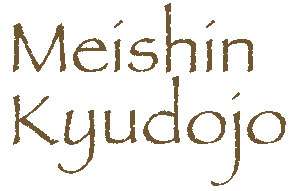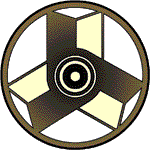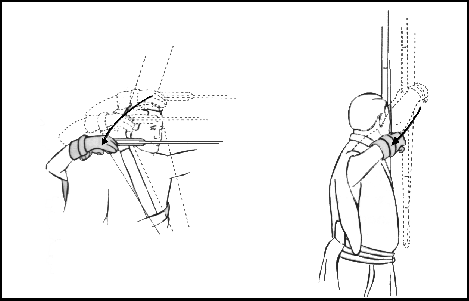
 |
|||

One Point Lessons
A collection of simple lessons
and explanations of Kyudo technique
Movement
We all learned to walk at an early age. So you would think we would have it down pat by the time we begin our practice of kyudo. The truth is, walking, and other simple kyudo movements like standing, kneeling and turning, are the elements that first reveal your understanding of kyudo to an experienced teacher. I have a fond memory of a visit to America some years back with Onuma sensei and a group of high ranking kyudo sensei and other practitioners when one of the Masters on the tour pulled me aside and told me that only when I learned to sit and walk like Onuma sensei would I truly understand kyudo. Unfortunately, after all this time still cannot move with the grace and elegance of sensei. Onuma sensei would float when he moved. Even at the age of 80 years he could kneel down in kiza and rise again from the floor with effortless grace. I am afraid I cannot offer much advice here on how to replicate his movement but I can tell you that constant practice and diligence are the key.
All too often in kyudo practice we tend to forget the simple things as we progress to ever more complicated techniques. But I was taught that from the moment you enter the dojo floor you must pay close attention to every action and movement you make. Do not focus on the shooting to come, but rather on the moment at hand. Be aware of your gaze. Check to be sure that your eyes do not wander and your head does not turn or bob. Keep your body straight as you walk, and do not sway from side to side. Every footstep should be of a regular stride and rhythm, and you must remember not to walk as if you are going for an afternoon stroll in the park. When you sit you should glide smoothly down to the floor in a straight line, and when you stand you should float straight up without wobbling to and fro. Onuma sensei's suggestion was to "rise as smoke rises."
Naturally, this all takes time and effort...a great deal of time and effort. But diligence now will pay off later when your kyudo technique begins to ripen. Keep in mind that here is nothing so ugly as an accurate, technically experienced archer who lacks the grace and fluidity of movement.
Yumi (bow)
A Japanese yumi is not particularly delicate, but a combination of poor care and poor knowledge of technique can destroy a yumi. I think it is important to discuss proper technique first since a bamboo bow can be damaged in a single shooting by an inexperienced archer. For this reason, many teachers, myself included, recommend fiberglass or carbon bows as a first yumi. Don't misunderstand, I dislike using synthetic materials in the practice of kyudo. Our teacher Master Hideharu Onuma likened them to using plastic plates and cups at a formal dinner party, and from the very beginning of our study insisted that my wife and I use bamboo bows and arrows. Nevertheless, in countries outside of Japan, the number of kyudo instructors knowledgeable in the proper care and use of a bamboo yumi is small and access to them is very limited. In good conscious I could never recommend that a novice buy a bamboo bow knowing that the potential is very high that they will damage it without someone to assist them with its care and use.
That said, one should remember that bamboo is sensitive to extremes of dryness and moisture. Extreme cold can be a problem but this can be alleviated by warming the bow with a soft cloth before shooting. Optimum humidity is in the 50%-70% range. If the air is too dry use a humidifier in the room where you store the bow or periodically rub it down with a damp cloth and then dry it off. When temperatures drop below freezing one should stop to warm the bow periodically. Bamboo bows should not be waxed or oiled. A soft (preferably silk) cloth should be used periodically on the yumi. In time it will develop a natural patina.
Another source of potential problems is the use of extreme strength in holding or pulling the bow. One should grip the bow with just enough pressure to keep it from sliding out of your hand. And most of the pressure used should come from the little finger (see our book, Kyudo: The Essence and Practice of Japanese Archery for more details). Likewise, the right arm should turn inward with just enough pressure to hold the arrow in place. Also, be sure to keep the string properly adjusted. Every bow is different but the distance between the string and the grip should be about 15-20 cm at all times. Also, the loop at the top of the bow should not be tied too open or closed. All of these conditions can result in the string being thrown and the bow being twisted at the release; and that can mean a sudden death for the yumi.
Yugake (glove)
For the most part the care of the glove means keeping it clean and dry. Always use an underglove (remember not to store a wet underglove next to your yugake) and avoid touching the glove to a sweaty arm or forehead. If it becomes soiled DO NOT USE A SOLVENT or other chemical cleaner. These will harden and stain the deer skin glove. Instead, use a natural gum eraser and try to "erase" the dirt.
Ya (arrows)
Bamboo arrows are susceptible to the same conditions as a bamboo bow. You will need to follow the same precautions in humid or dry climates. Unlike a bamboo yumi, however, bamboo arrows can be oiled. Walnut oil or oil from the camellia flower are traditional. Feathers can be LIGHTLY steamed and stroked into shape. When replacing nocks or points never use epoxies or other "hard" bonds. They will damage the bamboo when it is again time to remake repairs. Kusune (pine pitch) is one traditional bond but it loosens easily in cold or hot weather. White glue is the most commonly used glue today. It provides a long-lasting bond and loosens easily after a bit of steaming.
The distance between the feet is generally equal to the length of your yazuka, or arrow length. But many beginners use arrows of excessive length for the sake of safety. If you are using your arrow to determine the spacing, first make sure of its proper length (see the arrow listing under the Equipment section of this homepage for proper measuring techniques).
Positioning is equally important. The position of your footing can have a marked affect on your ability to hit the target's center. A stance that is slightly off-center can cause the arrow to hit to the left or right of the target. Too narrow a stance can cause the arrows to hit low, while an excessively wide stance can cause the arrows to hit higher than the target's center.
An experienced instructor will take all this into consideration when determining the proper distance of the footing. They may also use a person's body type as a guide to a proper stance. Someone who is tall, for example, may be better served with a slightly more narrow stance if they consistently hit above the target's center. A non-standard stance may also be required for a person whose body type differs greatly from the norm. Balance, accuracy, look, and feel are equally important elements when determining a correct ashibumi.
The problem of a correct tenouchi is one that affects every kyudo practitioner, both novice and advanced. A tenouchi is more than a matter of gripping the bow. It is a unique method of holding the bow used only in Japanese archery. The asymmetrical design of the Japanese bow coupled with the outer placement of the arrow combine to create a need for a special gripping method. The shorter lower limb of a Japanese bow causes the arrow to have a natural tendency to fly upward, while the outer placement of the arrow causes the arrow to fly to the right. This is the reason a novice practitioner invariably shoots high and to the right of the target. The mechanical working of the tenouchi is designed to compensate for the natural tendencies of the equipment, and until the tenouchi is thoroughly researched and understood, successful, consistent shooting will remain elusive.
Unfortunately, a correct tenouchi is impossible to learn from a book or written forum such as this. But the following basic points may help you in your study:
1) When creating the tenouchi, extend and flatten your left hand so that the fingers are in line and snug against one another.
2) Place the hand along the left edge of the grip so that the edge is parallel to the base of the fingers.
3) Fold the last three fingers (as one) lightly around the right edge of the grip. Leave a space between the middle joint of the fingers and the grip.
4) Lower the base of the thumb so that the flesh between the "Y" of the thumb and forefinger is pressed downward. Continue to lower the thumb to meet the top finger (middle finger), covering the top half of the nail.
5) Gently squeeze the base of the thumb toward the base of the little finger to slim the silhouette of the entire hand. Simultaneously, have the feeling of pushing the thumb toward the target. The combination of these two actions will create the torque that is necessary to control the bow. The Japanese yumi is constructed to compensate for this technique.
6) Alignment of the arm, wrist and hand varies among styles of kyudo but generally speaking the crease of the arm (at the elbow) should be vertical and the hand should not be bent to the right or left at full draw.
7) When holding the bow use only the pressure necessary to keep it in place. As you begin the draw slightly increase the pressure on the grip to accommodate for the pull of the bow, but do not squeeze beyond the necessary amount.
This last point is crucial to correct shooting but will take careful study and a great deal of practice. Be prepared during your study of a proper grip for the possibility that you may drop your bow a time or two when you release. Arrows that begin to consistently fly to the left or downward show that the tenouchi is working, but overly so. Relaxation of some of the tension in the grip should straighten the flight of the arrow...given that everything else is properly aligned and technically correct. But, hey, that's what makes kyudo so interesting.
The following One-Point Lesson touches on something other than technical training. Our teacher, Onuma Hideharu, was fond of saying that it is never too soon to begin developing the spirit. However, there are instructors who disagree with that approach. Their belief is that matters of the spirit are not teachable and that it is a waste of time to devote any part of your study to anything other than technical proficiency. In one sense that view is correct. The development of the spirit is an ongoing, personal experience. A teacher may lead the way by his or her example but there is very little they can do to actually "teach" spirit. But as Onuma sensei also liked to say, "If one day you wish to have a large, beautiful pine tree as the center-piece of your garden you do not wait until you are old to plant the seed. The seed must be planted early and the tree nurtured over the years if it is to be truly grand at the end of your life." The same can be said of the development of the spirit.
We are often asked what makes kyudo so special; what does it offer the kyudo practitioner that they cannot find elsewhere. Without hesitation we always answer, "nothing." That is because kyudo is only one pathway among many as we travel through life. The three essential elements of kyudo, Truth, Goodness, and Beauty, are by no means exclusive to the practice of kyudo. These qualities have been an integral part of many cultures throughout history and are fundamental to the creation of our arts, philosophy, and religious activities. So why do most great kyudo masters impress upon their students the relationship between spiritual development and kyudo practice? Because it is an excellent vehicle for the study of the human character and condition, and it works well in concert with all of life's other spiritual paths. Everyone that watches an accomplished kyudo practitioner is struck by the simplicity of the act, and it is easy to imagine that the same thing goes through their mind as went through ours upon seeing kyudo for the first time: That there doesn't appear to be much going on. It's just a matter of memorizing a few simple moves and holding the bow steady. The target is not that far away. There is no extreme physical exertion. No screaming and jumping about. All said it appears simple enough to be learned in a few sessions. Our teacher even supported our thoughts when, at our first meeting, he said, "Kyudo is a simple art consisting of just eight basic movements which take no more than a few minutes to complete. The practice of kyudo requires only that you align your body with the target, stand straight, fill yourself with spirit, and shoot with a pure heart and meaningful purpose."
Simple enough, we thought. But, we were in for a shock. Both of us are quick learners with good powers of observation and the ability to correctly translate physical movement into being. Kyudo looked easy enough, but that view quickly changed when we first picked up a Japanese bow. Never mind about shooting with a pure heart and meaningful purpose, it was completely overwhelming to simply keep the arrow nocked to the bowstring. It was very frustrating to say the least. For a long period of time all of our training sessions were of a strictly technical nature, giving weight to the idea of teaching technique and ignoring the spiritual aspects of Kyudo. So why did Onuma sensei insist that spirit was equally, if not more, important than technique? Because there are many levels to the development of the spirit and the first goes hand in hand with the process of learning anything new: It is the recognition and, later, the development of one's personal character. It is human nature to experience frustration, anger, joy, pride, and embarrassment when learning. And while it is extremely difficult to eliminate those emotions it is possible to temper your responses to them. And that should be one of your first considerations as you begin your practice of kyudo.
In order to control your reactions to a situation you must first recognize your reactions to a situation. Sounds simple, but while immersed in the trials of learning something new the last thing on our mind is self-reflection. As a kyudo practitioner, however, you must make a conscious effort each time you shoot to mentally document not only the technical aspects of your shooting but your emotional response to the shooting as well. In time, a recognizable pattern of behavior will emerge. Kyudo is an art and, as with any art form, personal emotion is reflected in the content of the art. In kyudo, anger will make your shooting tight and uncontrolled, frustration will create unsettling nervous tension, and excessive pride will rob the shooting of its beauty and elegance. It is that knowledge, and the ability to use the knowledge to control emotional self-expression, that separates a true master of kyudo from a person who is merely technically proficient. It is also why an aging master, who may suffer from diminished physical capability, can still inspire all who watch them with a shooting style that is far beyond that of a younger practitioner. And it is that knowledge and control that every new kyudo practitioner should seek out for themselves, even in the early stages of their study. It is the essence of kyudo, and a sure path to a deeper understanding of what the Masters mean when they talk about truth, goodness, and beauty.
The yugaeri, where the Japanese bow turns in the left hand after the release, is an action where the bowstring travels from its original position on the inner left arm to the outer side of the left arm. It is unclear exactly when and why the yugaeri was incorporated into the shooting method. Some sources suggest that it first appeared around the fifteenth century when major changes were made in both bow construction and shooting technique. It is almost certain, however, that it was used initially in ceremonial archery since in true battlefield archery the bow is held in a way that restricts its turning action so that the archer can more quickly nock and shoot subsequent arrows. Today, however, the yugaeri has been adopted by most shooting styles, including those based on battlefield technique.
In the shooting form, It is important to understand that the yugaeri is not a technique. It is an action that results from a correct tenouchi. The yugaeri allows the archer to return to correct toriyumi no shisei (bow holding posture). This is the beginning and ending shooting posture where the bow and arrows are held at one's side. If the yugaeri is incomplete the bow must be readjusted after shooting in order to return to the correct posture, and that action takes away the fluidity of the shooting procedure. For this reason many kyudo students quickly want to learn how to make the yugaeri. However, because a proper yugaeri is the product of a correct tenouchi (bow holding technique), it takes considerable study to learn. As a result, students sometimes find ways to cheat; the most common being the loosening of the grip at the release. This produces a false yugaeri; the bow turns but it also drops in the hand. With practice a student can eventually learn to catch the bow before it drops excessively, thus creating, in their mind, the yugaeri.
But creating a false yugaeri is a very bad habit to get into. The action of releasing and catching the bow can only be done at the expense of a correct tenouchi. And it is the tenouchi that stabilizes the shooting. To create a false yugaeri at the expense of a correct tenouchi is an act that will return again and again to haunt the archer in later years. It is extremely difficult to unlearn a false yugaeri, often requiring more time and study than learning it correctly in the first place.
Our teacher taught that, initially, one should not overly worry about the yugaeri, but should concentrate instead on a correct tenouchi. That subject has already been covered in a previous One Point Lesson but I would like to expand on the subject here as it pertains to the yugaeri.
When a Japanese bow is held correctly in the position of yugamae, the outer face of the grip sits flat against the palm while the fingers rest alongside the inner, rounded part of the grip. It remains in that position through uchiokoshi (the raising of the bow). As the bow is being drawn, and moved into daisan (the half-draw position of hikiwake) the grip, while still under the torque of the hand, will appear to turn slightly so that it sits diagonally between the base of the forefinger and middle joint of the thumb. However, it does not actually move. It is being held in that position under the pressure of a correct tenouchi. From that point on, the pressure on the grip ismaintained as the draw is completed. Because the bow is held under pressure, it will appear nearly square in the hand at full draw (the outer surface of the grip will face the target), but if the string is slowly allowed to return to its un-drawn state the grip will return to its diagonal position and the string will rest about five centimeters or more from the forearm. This is an indication of a correctly functioning tenouchi, and the basis for a true yugaeri. When held under torque this way, the bow will naturally turn when the string is released in full draw. A well made Japanese bow is designed to compensate for this torque. It may take some time and practice before the string travels completely around but you should resist any temptation to cheat at this point in your study. Your dedication will be rewarded not only with a true yugaeri but also with a better tenouchi and, ultimately, with more consistent, correct, and accurate shooting.
 |
||
This lesson is very short in explanation but it was one of the most crucial lessons we learned in regards to proper shooting technique. Simply stated, you must think of shooting 3-dimensionally. According to Onuma sensei it is very easy to get caught up in the left to right movement of drawing the bow. But such movement results in flat, lifeless shooting. To correct this you should take care when drawing down from daisan to also move the bow toward the back of your body; as if you were trying to surround yourself with the bow and string. An old teaching says to touch your shoulders to the arrow. Be careful, though, not to take this instruction too literally, you do not actually get your shoulders that close to the arrow. If you use a lightweight bow you must also be careful that you do not overdraw when practicing this movement.

It is very common when learning anything new to want to quickly move away from the basics. In kyudo, new students sometimes believe that the earlier they learn the Hassetsu the quicker their teacher will move on to more important instruction. The problem with that thinking is that the Hassetsu themselves are the most important element of proper shooting. One should not think of them as basic in the sense of "simple" but as basic in the sense of "crucial." Watch a highly skilled kyudo master and you will notice that they haven't left the Hassetsu behind. Instead they carefully and precisely perform each step of the Hassetsu, just as a novice does. But unlike the novice, the Master transitions through each stage of shooting with a natural ease that is the result of long years of study. The Master understands that the Hassetsu, like the nodes on bamboo, are separate yet critical parts by themselves, but become most important when they combine to form a unified whole.
| This site is maintained by Dan and Jackie DeProspero, co-authors with their teacher, Hideharu Onuma Hanshi, of the books Kyudo: The Essence and Practice of Japanese Archery and Illuminated Spirit: Conversations with a Kyudo Master http://www.kyudo.com.html—Revised April 2, 2012 Copyright © 1998 Dan and Jackie DeProspero |
||